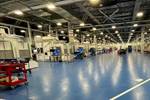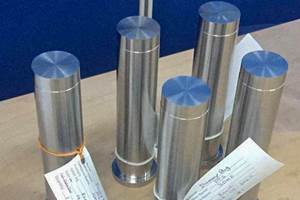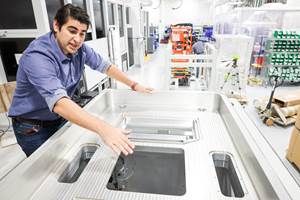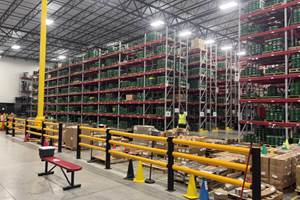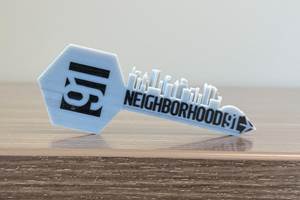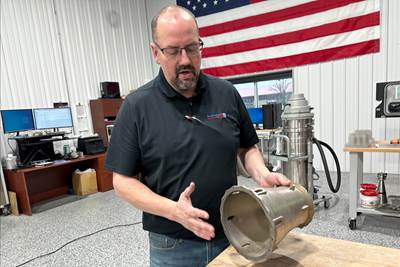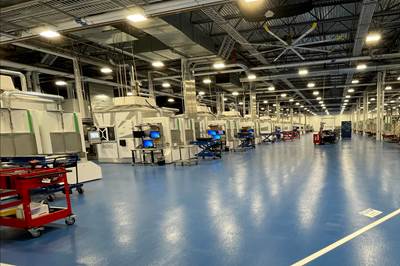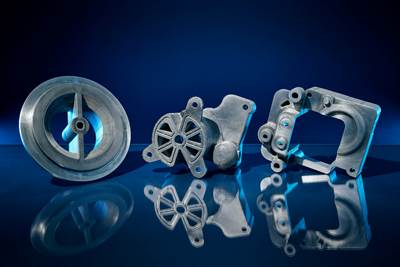We are trying something new on the podcast! Whenever one of us on Additive Manufacturing Media pays a visit to a manufacturer for the first time, we want to talk about the trip as soon as we return. Why keep this recap to ourselves? In this episode of AM Radio, here is Stephanie Hendrixson getting the full download just after I paid a visit to Innovative 3D Manufacturing in Franklin, Indiana. Innovative does contract production using 12 laser powder bed fusion machines, all from Renishaw. Just part of what struck me is this company’s connection to foundry work — not just in terms of process, such as workholding technique, but also in terms of business opportunity, because Innovative is getting work due to foundry leadtime challenges. Listen to our conversation above, or on your favorite podcast app. And for even more on Innovative, read the article I wrote, which is linked below.
Transcript
Stephanie Hendrixson 00:05
One of the things that additive manufacturing editors do is travel to visit production 3D printing facilities. Today on the show we have a trip report from Pete Zelinski all about a user of laser powder bed fusion located in Indiana. That's coming up stay tuned.
Fiona Lawler 00:27
AM Radio is a product of Additive Manufacturing Media. So are The Cool Parts Show, The BuildUp and Additive Manufacturing magazine. Ready to be a part of the AM universe? Subscribe of AdditiveManufacturing.Media today
Stephanie Hendrixson 00:42
Welcome to AM Radio, the show where we tune in to what's happening in additive manufacturing. I'm Stephanie Hendrixson. I'm joined today by Pete Zelinski.
Peter Zelinski 00:49
Hi Stephanie.
Stephanie Hendrixson 00:49
Pete, you recently posted an article about this company Innovative 3D Manufacturing. It's now on our site AdditiveManufacturing.Media. The title is "How machining makes AM successful for Innovative 3D Manufacturing. The article gets into a lot of what makes this laser powder bed fusion producer successful.
Peter Zelinski 01:08
Right and right when I came back from visiting that manufacturer, before I wrote the article, I wanted to tell you all about it. But this time we did something new, we recorded that conversation. Yeah, so a lot of times, if one of us does a visit without the other one, we come back and we want to talk about it right away. And usually that just happens off tape. And this time, we decided to just capture your impressions right away so we could share them now when the article is available. I do want to say up front, you don't have to have read the article for this conversation to make sense. And once you've listened to the episode, you should also probably go check out the article, there's going to be different things in each place. Right. So we're going to play the recording of that conversation now. Pete anything you want to say? Yeah, when we were talking, I got one number wrong, you'll hear me jump in and correct that when we get to that moment in the tape. And also, we have left out the part where we make reference to Innovative's employee headcount because that number actually increased since I made my visit. So Innovative has 12 employees as of this recording, including co founder Chris Beck, who was my host.
Stephanie Hendrixson 02:12
Alright, let's get into it. Here's the hot take I received after Pete's visit to Innovative 3D Manufacturing.
Peter Zelinski 02:21
So Stephanie, I was just at Innovative 3D Manufacturing in Franklin, Indiana, southern Indiana. And this is the first time we're talking since I made this trip. You know nothing about it.
Stephanie Hendrixson 02:33
Absolutely nothing. I don't even know if you were seeing polymer or metal 3D printing or some other strange material.
Peter Zelinski 02:39
Metal, laser powder bed fusion.
Stephanie Hendrixson 02:40
Okay. So give me a sense of who this company is and what they do. They have 3D in their name. So I'm going to assume that they were created and evolved with 3D printing in mind. But maybe that's not the case.
Peter Zelinski 02:52
Created with 3D printing in mind. They are a contract part producer, additive manufacturing, laser powder bed fusion. It is a startup run by one of the co founders, but another co founder and investor is an owner of a successful casting business. So this is like a sister company to that business. A dozen Renishaw laser powder bed fusion machines. And within this facility that, boy, I should have gotten the square footage, but I didn't. But it's one of these Indiana manufacturing facilities, which is like it's a building that has been used for other purposes in the past, and it is the most utterly nondescript building. And it's about the size of like a medium sized retail space like it's way smaller than a Target but bigger than a strip mall store like it's sort of in the middle. It's definitely the size of a, on the inside, of a smaller job shop. You go inside and there is this row of Renishaw machines, and they're chugging away. And they're doing production and machining capability to and I think we're going to talk about that. Existed for four years. No venture capital backing, and they've been profitable every year. Pete here, actually, they've been in business seven years, back to the episode.
Stephanie Hendrixson 04:16
So you said a couple of interesting things here. Like I can picture this building that you're describing, and I can see this row of machines, 12 Renishaw machines, that's not an insignificant number of laser powder bed fusion printers to be, to be in one place. So they're pretty serious about this.
Peter Zelinski 04:31
Yes. And we have struggled with what to call facilities, businesses that are like this, like they're not a shop. That's where you do machining and they're not a foundry, that's where you do casting. So what are they? And we fairly recently, we've landed on this term AM factory and at least for now, that has proven to be a useful handle for describing these kinds of facilities. Well, to your point, this is an am factory with a pretty substantial amount of industrial metal additive production capability. In, as I say, this kind of nondescript building, there's a distinctive thing about it, and I couldn't put my finger on it. And I couldn't put my finger on it. And I didn't think of it until I was all done with the visit and was driving away. You and I have been to a lot of additive production facilities. And they often have something in common. And I'll see if it if it comes to your mind. You and I were recently at Neighborhood 91 in Pittsburgh, additive manufacturing campus near the Pittsburgh airport. And for the initial building of this industrial park, it's full, the tenants are all there. And we have been to every one of those tenants and seen them all. And we've talked about something they all have in common, something about their facility.
Stephanie Hendrixson 05:56
Lots of open floor space.
Peter Zelinski 05:57
Lots of open floor space back. That was the light bulb that went out as I was driving home. Oh, Innovative 3D. I mean, it's not utterly like cramped facility, but they do not have abundant floor space. Like it feels like another more conventional like long running manufacturer.
Stephanie Hendrixson 06:16
Okay. So they have achieved a level of production in this facility that kind of kind of fills the floor plan.
Peter Zelinski 06:25
Yes. And they're producing, they're producing, they run seven days a week, they have, I believe, like 10-hour work days for five of the days. And then on Saturday and Sunday they're in for a few hours, each of those days just to keep things moving. Friday is the really busy day, because they're setting up for really long runs through the weekend. But I was there on a Tuesday. Chris Beck is the founder. And and he runs the facility. But I asked Chris, okay, it's Tuesday, midnight tonight, how many of these machines will be running, you know, dozen Renishaw absolute machines, he looks around, he kind of like make some analysis, counting his fingers. And he says nine, nine of these machines will still be producing at midnight tonight. So like he didn't do anything special for me. I was there on a random regular day. And these machines are producing and they're they are doing lots of additive production.
Stephanie Hendrixson 07:20
Let me go back to something that you said earlier on. So this is a startup, but it is associated with this sister company that does castings. Yes. And so I guess I'm wondering, we've we've had a lot of conversations in the last year or so about 3D printing as an alternative to casting as an alternative to forging and that like, I wonder if the origins of this company kind of come from trying to solve that problem. Or if there's something else here? ,
Peter Zelinski 07:46
Well you hit on something really interesting. So the the origins, I'll start there, Chris Beck has a foundry background, he kind of became fascinated with additive and just saw the promise of it and wanted to build a business there. His partner, his investor is not someone I spoke to, but you can you can kind of see his partner quite likely sees the same kind of promise and opportunity. But as far as the origin level of connection to foundries, the way you see it is they're good at machining additive parts. Part of that is because they know from foundry experience, how to quickly and efficiently make workholding for things that are shaped strange. And you saw all kinds of examples of that learning being directly applied to additive. But you asked the question about additive replacing foundry work of 3D printed parts, offering a quick lead time solution to what might be a long lead time wait for cast parts in the supply chain. So there's a ton of that going on. One of the things that I couldn't do when I was there, per my agreement with Chris, I didn't take any pictures of parts he's producing. There was a part we photographed and talked about, it wasn't even one that was in active production on that particular day, all the parts being produced on that particular day and all of the ones like staged for next steps in the process, they were all under some kind of proprietary or protective relationship. And we encounter this all the time. And so I didn't I didn't take photos of the parts. And I won't describe in specifics what I saw. But Chris said, there are way more metal 3D printed parts out in the world than anybody knows, because established and commonplace manufacturers are running into this foundry supply chain problem all the time. And they are routinely turning to additive manufacturing as the short term bridge solution. And his company gets involved in that frequently. He's just said as none of them want to talk about it, none of them want to talk about that happening. But some examples that I saw, and that we talked about roughly land in the world of cars and trucks and overland transportation. Components, again, that were never designed to be made additive, and you look at them, and you realize they're not additive parts. But they're being 3D printed in large batches on laser powder bed fusion build plates, because that's the way to get this component right now. And he says that there's so much more of that out there than we realize and speculating, speculating. But I could kind of see why the companies that are turning to a solution like that, wouldn't want to talk about it. Because if you're, if you're a major manufacturer, you want it to be understood that every single product you make is identical and made the same way with all the same parts. And so you wouldn't really want to shine a spotlight on a variance like that. Even though Chris said, like, ironically, the laser powder bed fusion part is almost always superior in quality to the casting that it's replacing on a short-term basis.
Stephanie Hendrixson 11:10
So I've never heard anybody say that out loud. But it sort of doesn't surprise me to hear that, like it calls to mind the saying that, you know, if you've got one cockroach in your house that you see, like, there's a dozen more that you're not seeing. And we can point to examples of the cockroaches that we've seen, not calling the 3D printed parts, you know, insects, but for every example that we're allowed to photograph and talk about that there are dozens of others out there that just have not been publicized, or will not be publicized. Not surprising.
Peter Zelinski 11:43
I'm going to stipulate to and accept the cockroach analogy, okay. I mentioned that they've been profitable every year since they began. That was another interesting aspect of it. And the extent of their machining capability is a big factor in why that's true. Initially, first year, it was it was hard to get additive jobs, they were they were looking around for them, they were putting their name out there. And they ended up doing a lot of job shop type machining as just the work they would do to pay the bills. And that was enough to keep them profitable while the additive work began. The Machining now supports additive. That's why it exists. There are still some parts that come in that are just machined, there is still some work that he does. But the the machine the machining capacity supports additive to such an extent that he's to the point now where he's wondering, should they get away from short run or prototype machining completely? That's not related to additive because the additive demand is there and it's advancing? That was the answer in the beginning, the way that machining keeps them profitable now is because he says the secret to it, the secret is do not have build failure, build failure. Easy. Right? Right. Build failure is just so expensive. And he says, I'm not saying we never do. But he's well north, the businesses well north of 90% in terms of the frequency with which they run a new job first time right as they expect it. And the way that they do that is just over specking support structures and putting too much extra stock on just in the interest of making sure there's no way that the part distorts because they're very good at machining and and they don't mind machining and additive part aggressively to get it to tolerance. That is way easier to do and way cheaper and more efficient than risking having a build failure by going light on the material here or there when it's being 3D printed.
Stephanie Hendrixson 13:52
So 12 laser powder bed fusion machines, what does the machining capacity of this facility look like?
Peter Zelinski 13:59
Oh, good question. Fewer CNC machine tools than that, but not by much. And so I mentally ticking through the list of there's, I believe two wire EDM machines for separating parts from the plate. There is one vertical machining center that's devoted to resurfacing build plates. They go through six to eight build plates every day. And then there are a couple of machining centers that are doing finished machining work on additive parts, at least one other one while I was there that was devoted to making a complex machined prototype part. And machining for prototyping is actually another interesting aspect about this we can touch on if we remember. Then there's there is this knee mill, and an email is a simpler milling machine. It's open this one was CNC controlled, but it's just machining redboard which is a machinable polymer material what I was one watching it, it was making a fixture for an additive and Inconel additive part that was going to be machined. But then in addition to everything I've just said, there are two lathes, two CNC lathes, and I don't often see lathes doing postprocess machining for additive parts, but they do here because one of the markets that they serve, not their biggest market, but but a major market is firearms. And certain firearms related components I saw are roughly cylindrical, so that turning on a lathe was the right way to post process them. In addition to I saw medical components that are very strangely shaped, but require some circular features, and they make crazy fixtures for the lathes so that they can mount them and spin them and do the circular machining that way. So your question, I think, I don't know what that tally lands on. But I'm gonna say approximately 10, probably 10 different CNC machine tools
Stephanie Hendrixson 16:05
in the prototype, machining is still an ongoing activity.
Peter Zelinski 16:09
So here's the other way machining helps them. So that word prototype. So among the additive work that they do, right now, it is about 60% prototype and 40% production. He says when he looks at the business that he knows is coming or has line of sight into giving him high confidence in what's coming. He says in a year, the business will be 30%, prototyping and 70% production in its additive work, including prototypes, they run like 80 to 90 jobs per month. So right now 60% of that is prototypes, they do a lot of prototypes. And he said, you know, the the crazy thing about it is like that's what's really fun, for they've got three engineers on the shop floor, and they're laying out jobs. And they're like a day ahead of where the production is on the additive machines and getting a new part and figuring out how to lay it out and figuring out how to support it and how to build it. That's the intellectual challenge. And it's fun. And the thing that you want to have happen, it just transfers into production, and you're running the same build again, and again, like that's where the money is. And that's also where the excitement ends. So they do a lot of prototyping, and they like that, and they're good at it. So they have this prototype mentality for how they do work and how it flows through the shop. So getting a vendor code with a larger customer, as a machine shop is very difficult. Because these companies already know a lot of machine shops, and they believe they have all of the machining vendors they need. Oftentimes, getting a vendor code as an additive part producer is much easier. There's not that competition for that, once you have the vendor code, it doesn't matter what work you're doing, then you're in and they know you can do additive, but then eventually they discover Oh, you can do machining too. And the work comes because among all those machine shops that have the vendor code in the main, most or all of them don't want to do prototyping, they want to do Production Machining. But this business innovative 3D because of its focus on additive, it's very focused on on complex parts it sees for the first time it's very focused on prototypes and difficult prototypes. And so it's pretty straightforward to translate that culture to machining to so when I was there, I saw some some geometrically sophisticated IT WAS tooling it what it was what it was, it wasn't prototypes, but still one off parts being made for an aircraft industry customer and there's nothing additive at all going on but they were they were these complex one off parts that they were making and running through their process and they get that kind of work and they're they're set up well for that kind of work.
Stephanie Hendrixson 19:05
So they've kind of found the backdoor into like becoming part of the supplier databases. That's
Peter Zelinski 19:09
right That's exactly right. Yeah.
Stephanie Hendrixson 19:11
All right. Let's take a quick break
Fiona Lawler 19:18
this episode of AM Radio is brought to you by Additive Manufacturing Media, your source for the latest news and innovations in additive for industrial production. The editors of Additive Manufacturing Media report on am applications and Additive Manufacturing Media magazine, the buildup newsletter and The Cool Parts Show video series. Whether you're successful additive manufacturing already or considering adoption Additive Manufacturing Media will help you discover the latest and 3D printing technology and applications. Find all of our reporting industry news, educational webinars and more at additive manufacturing dot media and subscribe today to join the am universe
Peter Zelinski 19:59
we're Back, Here's more of our conversation after my visit to innovative 3D manufacturing in Franklin, Indiana. So
Stephanie Hendrixson 20:06
I guess I'm getting this picture of this metal 3D printing facility that is also good at machining for the post processing of 3D printed parts, but also just machining in its own right. And they've sort of carved this niche out for themselves. That is, we want to do prototyping, we want to get in kind of on the ground floor for some of these parts, we want to work on things that we've never seen before. And that is leading them to a lot of prototyping work, but also a lot of production work. And that and that balance is starting to shift a little bit.
Peter Zelinski 20:37
Yeah, they do machining, that is that is not additive. But additive manufacturing is what they were founded for, and is the core of the business and is what it's all about. But Chris continued to paint this picture of how connection or familiarity with other manufacturing operations, is helpful to additive work comes to him potential additive work, and he's candid, he says, like, of the parts that come to him, one in eight parts is a good candidate for 3D printing, the vast majority of what he sees still isn't. And the temptation is to take it on anyway and do it anyway. If somebody wants their part 3D printed, and and there are the supply chain stuff we talked about sometimes that that casting lead time is the reason why a part not designed for 3D printing gets 3D printed anyway. But in a lot of other cases, that's not the case. And he says it's it is not in the interest of the business to take on work like that, no matter how tempting that might be. Because if it succeeds, and it goes forward and shifts to production, they're eventually going to figure out that there's a better way to do this. And so he says, the way to develop your customer portfolio as an additive contract producer is in part by being the manufacturing consultant who can direct the jobs that come in to other processes that makes sense for them. Yeah,
Stephanie Hendrixson 22:10
and I think we've seen that with some other companies that having experience in say, injection molding, as well as polymer, 3D printing gives you a little bit more credibility, when you're suggesting to your customer that, hey, you should think about 3D printing this are really this is a better fit for molding. Yeah.
Peter Zelinski 22:26
And Chris said, when people come to him, and they say, additive is expensive and slow, his response is always will like, yeah, that's because you're printing something that never should be made that way. So work that makes sense for additive, he's actually got this very specific picture of what that is. And so interestingly, a dozen Renishaw additive machines, four of the four laser ones, and the other eight are the older style single laser machines, they used to fight material changeover. He says, getting lots of machines is the answer. So they have three that do it go 718, one that does 316 stainless one, cobalt, Chrome, two aluminum 217, four stainless, one Inconel 625, one Mirage, and steel, one titanium.
Stephanie Hendrixson 23:20
So the magic number of one dozen machines is actually more like what's the material breakdown that you need? How many materials do you need to support and how many machines for each one?
Peter Zelinski 23:29
That's right, and he says they have not gotten away from material changeover. They still do it. But what I just described is their mix of dedicated machines right now. And that's probably a picture of what the right material proportion is pretty consistently what they're seeing right now. But these are the parts that make sense for additive like it's he says, it's got to take a lot of boxes, it's often super alloy, hard to machine, thin wall or complex geometry, and a design that gives a performance enhancement. So the the work that's really good for additive often satisfies all of those requirements. And that seems like a lot of boxes to check. But he's built this successful business on the fact that actually, there are a number of parts that check all of those boxes, and there are enough parts to check all those boxes that you don't need to stretch or over extend the capabilities of additive to try to make it produce something it wasn't meant to produce. So
Stephanie Hendrixson 24:33
one out of eight parts, kits 3D printed what happens to the other seven.
Peter Zelinski 24:37
I think in some cases, he says we could machine this for you just as readily but I suspect in talking to them that a whole lot of those parts. He says we're probably not though the one for you. You could do this out of sheet metal. Have you thought of that? You could cast this part you could make this through investment casting you He showed me apart that for the sake of an experiment and testing for the customer, he made the exact same component, laser powder bed fusion and had it made investment castings, same geometry, same part, they wanted to test it. And he said like that company was really interested in 3D printing. But in the case of that part investment casting made a ton more sense. And I think he would have, he would have directed them there and been happy to see them go. And like maybe when the company was first in, its in its very first days, and he was looking for work. Maybe that was harder to do. But I think he's seen had to dip is very viable, and he could expand if he wanted to. So he doesn't have to take on jobs that he doesn't have to take on. His question really, right now is how aggressively should he grow? And and to what extent should he what kind of controls should he put on the scale of what the business might be? I guess part of that also is he pointed out how, in his view, younger people coming in, in engineering or manufacturing roles, have less knowledge of or tactile connection to various manufacturing processes. And so whereas he's been all over, he has worked in die casting, and he has worked in the machine tool industry. And so he is valued and trusted, because he can speak to manufacturing processes, including those that aren't in the building with them and aren't in company with them. And, and I have a feeling that that relationship and that role builds confidence in people who maybe bring one part to him that he can't 3D print, but maybe, yeah, maybe they keep bringing in parts, and then they hit the one out of eight sometime. It's at some point, what have I not asked you about? Yeah, right. I don't know in what context it came up. But he said right now they have 300, NDAs in place. That's a lot of secrets to keep. I know, right? 300 in the A's in place. He got he gave interesting numbers. He also said in the history of the business so far, he said, I believe we've now produced 12,000 different geometries. He said that people do not get part consolidation. It surprises him how often he has to bring that up, like a part having an additive part that's having some kind of fit issue for him to say, Well, why don't you just let me 3D print that whole sub assembly as a single thing and just forget the fit problem. And that is a revelation still to a whole lot of people. It's not well embraced.
Stephanie Hendrixson 27:40
Think it's a hard thing to visualize sometimes, like you're, you're looking for a solution for this one particular part. And you're not necessarily thinking about the whole sub assembly, and it probably takes somebody pointing it out to be able to see the possibilities there.
Peter Zelinski 27:54
Yeah, that's fair. I have that's I think that's very right.
Stephanie Hendrixson 27:57
So this sounds like a really worthwhile site visit. It sounds like you saw a lot talked about a lot. Maybe just as a as a final thought here. Was there something that you learned from this visit that you were surprised by or something you didn't expect to be thinking about as you as you drove away?
Peter Zelinski 28:16
Additive manufacturing is challenged right now in terms of vibe and perception. Because some company valuations have radically changed as a result of some of the VC money pulling out of certain places and additive where it had gone. But nothing about the promise of additive or why to adopt it, or why to use it has changed. Nothing about the reasons why this is going to account for a significant part of the future of manufacturing has changed. None of that is different. I understood that intellectually going in, but getting to go to innovative 3D was for the two or three hours I was there, just this utter immersive experience of that very fact. But Chris Beck, he is a shirtsleeves guy running a manufacturing business, and they are doing good work. And they are moving a lot of production volume through their facility. They're having well structured days every day aimed at using this capital equipment well to make customer parts, like they're just doing it because the work is there to be done. And that's what this looks like. And I don't know that I learned something new. But I had something wonderfully demonstrated and validated to me to a greater extent than what I was looking when I pulled up to the parking lot of just this utterly featureless square building in industrial Indiana.
Stephanie Hendrixson 29:58
That's a good reminder. There's been a lot of that kind of investment noise happening. But for people like Chris and other companies like this, it's not affecting their day to day they're they're going about their business. They are finding that one out of eight parts that can be 3D printed and they're delivering and yeah, everything else is kind of just background noise. So like we said at the top of the show, this is a new format for us. Let us know if you like it. You can do that by emailing AM Radio at AdditiveManufacturing.Media. Find us on social or of course leave a review on your podcast platform of choice thanks for listening.
Peter Zelinski 30:37
AM Radio is recorded with help from Austin Grogan. The show is edited by Jodee McElfresh and Stephanie Hendrixson. Our artwork is by Kate Schrand, AM Radio and Additive Manufacturing Media are products of Gardner Business Media located in Cincinnati, Ohio. I'm Pete Zelinski. Thanks for listening.
Related Content
ConocoPhillips Sees Oil and Gas Supply Chain Opportunity With Additive Manufacturing
Production of parts when needed and where needed can respond to the oil and gas sector’s multibillion-dollar challenge of holding parts in inventory. The supply chain benefit will justify additive even before the design freedoms are explored.
Read MoreSeurat: Speed Is How AM Competes Against Machining, Casting, Forging
“We don’t ask for DFAM first,” says CEO. A new Boston-area additive manufacturing factory will deliver high-volume metal part production at unit costs beating conventional processes.
Read MoreDo Distributors Dream of Digital Inventory? Würth Additive Group Does
It’s more than a dream for Würth Additive Group and its parent company, in fact. Along with supplying additive equipment, the group is now developing solutions for sourcing 3D printed parts in a reliable, elastic digital inventory model.
Read MoreWhat Is Neighborhood 91?
With its first building completely occupied, the N91 campus is on its way to becoming an end-to-end ecosystem for production additive manufacturing. Updates from the Pittsburgh initiative.
Read MoreRead Next
How Machining Makes AM Successful for Innovative 3D Manufacturing
Connections between metal 3D printing and CNC machining serve the Indiana manufacturer in many ways. One connection is customer conversations that resemble a machining job shop. Here is a look at a small company that has advanced quickly to become a thriving additive manufacturing part producer.
Read MoreThe Arrival of the AM Factory: How Proprietary Processes Deliver Production 3D Printing
Various recent articles report on companies using internally developed technology to equip factories and deliver on the promise of AM for production.
Read MoreIs 3D Printing Competing with Casting? AM Radio #27B
On this episode of AM Radio, we discuss two examples of companies that are shortening supply chains by using 3D printing instead of casting.
Read More



